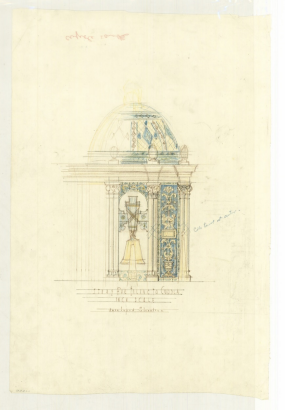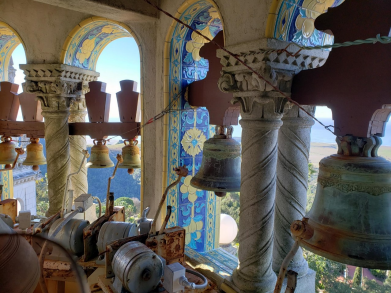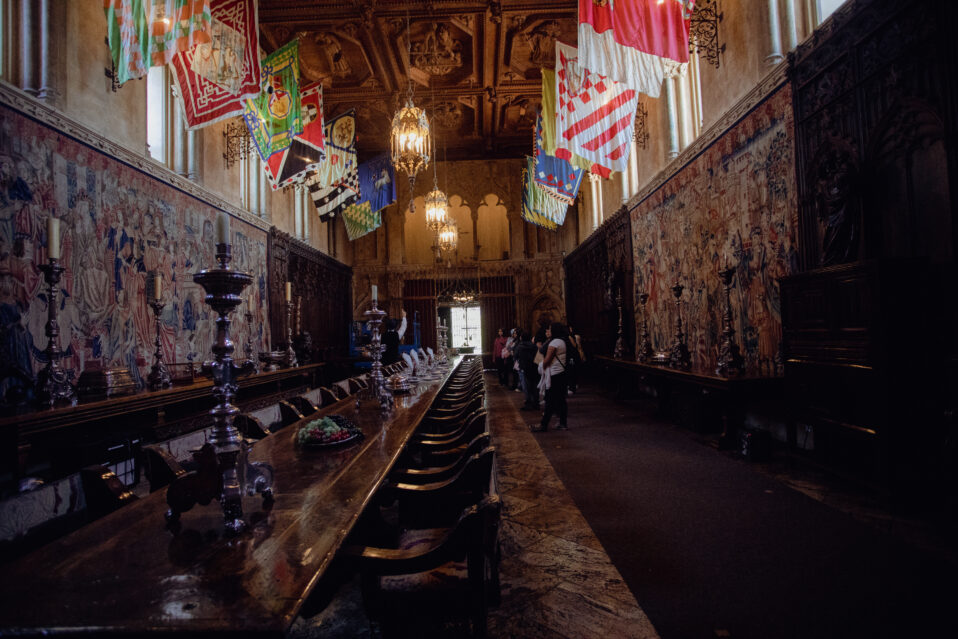The carillon bells, which sit in the two bell towers of Casa Grande, are some of the most iconic features of the Hearst Castle estate, and some of the most memorable for visitors who have been lucky enough to hear music played from them. Unfortunately, due to deterioration and iron corrosion caused by almost 100 years of weather exposure, these bells have ceased to play. A current rehabilitation project seeks to remedy the situation.
The origin story of Hearst Castle’s carillon system reveals the importance of this musical instrument to William Randolph Hearst’s vision for his San Simeon estate. Almost from the beginning of construction, Hearst knew that he wanted a bell tower (later to become two bell towers) to adorn the main house on the property, a design decision inspired by the tower of the Cathedral of Santa Maria la Mayor located in Ronda, Spain. In 1921, even before the ultimate design and size of the bell towers were determined, Hearst Castle architect Julia Morgan initiated correspondence with Marcel Michiels, a bell-founder in Tournai, Belgium. She engaged in five years of correspondence with Michiels, during which they negotiated the number of bells, style of playing mechanisms, and design of the player piano that would best fit Hearst’s and Morgan’s vision for Casa Grande, before the bells were finally ordered in 1926. In her letters, Morgan explained to Michiels that the carillon system was to be divided between two bell towers, an unusual arrangement for a single carillon system, which was normally placed together in one tower. Morgan and Michiels negotiated the details of the order from 1926-1929, during which time Michiels referred to Morgan as “Mr. Morgan,” a mistake only realized late in the purchasing process.
The bells were cast in bronze between 1927 and 1929. After many delays in casting and shipment, the bells finally arrived at San Simeon in October, 1931. The bellfounder’s son, Marcel Michiels Jr., arrived in California for installation in December, 1931. Weather conditions at the hilltop estate remained too volatile to begin installing the bells until February, 1932. Iron crowns were hastily constructed by Michiels and his staff to connect the bronze bells to their structural supports on site, eventually leading to corrosion caused by interaction of the incompatible iron and bronze materials.

Julia Morgan’s sketch of a bell tower, circa 1927. Hearst San Simeon State Historical Monument Archives.
Each bell was paired with an electrically-controlled striker mechanism positioned outside of the bell, which can be activated by pressing keys on the player piano located in the theater lobby of Casa Grande. Music rolls could also be inserted and played automatically through the player piano. In addition, each bell contains a traditional clapper inside the bell, designed by Julia Morgan. However, these clappers are only aesthetic, creating the appearance that they are used for playing the bells, when in reality only the external strikers are used for playing. During Hearst’s residency at his San Simeon estate, tunes ranging from pop to classical were played through the carillon bells.
The carillon consists of: 36 bells (18 in each tower), electric motors, external strikers, internal clappers, and wood and iron hardware that structurally support the bells. The bells sit in the openings of the two bell towers in Casa Grande and are visible to observers from below.
Since their installation in the bell towers, the carillon has been exposed to the elements and the iron elements of the carillon have rusted. These include the iron crowns on the top of the bells, the iron angled beam supporting the bells, and the motor housings, all of which contain extensive rust. The wooden beams and decorative yokes above the bells also deteriorated over the years.

Sketch of the clappers inside the bells, Julia Morgan Office, 1932. Hearst San Simeon State Historical Monument Archives.
In 2020, the San Luis Obispo Coast District received a grant from the Cultural Resources Division of California State Parks to begin the process of rehabilitating the carillon system. The goal of this project is rehabilitation of the bells, the motorized playing mechanisms, and their structural supports, returning them to their original condition when Hearst resided at Casa Grande. The first phase of the project, initiated in the summer of 2020, focused on rehabilitating the features of the carillon that were in the most deteriorated condition. 8 small bells that sit in the window openings of the bell towers were directly exposed to coastal weather patterns and thus were showing the worst signs of rust and discoloration. These 8 bells are currently being treated by a contracted conservator who is working to remove rust and re-seal the bells to allow for another century of use in the bell towers.

Inside one of the bell towers before rehabilitation began in 2020, showing the extent of iron corrosion and discoloration caused by weather exposure.
The 8 playing mechanisms that accompany each of these 8 smaller bells were removed from their positions in the bell towers and beautifully rehabilitated by State Parks restoration staff in collaboration with a contracted conservator. The rust was cleaned from the playing mechanisms and a rust inhibitor paint was added to ensure the mechanisms will be protected for the foreseeable future. Elements of the playing mechanisms were replaced in-kind when necessary, but due to the careful and patient work of restoration staff, most of the original materials could be retained and reused after cleaning. Cork tiles that served as vibration mufflers on the playing mechanisms had deteriorated over time and will be replaced in-kind with new cork boards.

One of the eight small bells that have been removed from the bell towers and are currently undergoing conservation. Note the severely rusted bell crown and attachments. These features are being replaced, and the bells cleaned, by a contracted conservator as part of the rehabilitation project.

A severely rusted playing mechanism in the State Parks restoration workshop after removal from the bell tower.

A rehabilitated playing mechanism, with a new cork panel and rust inhibitor coating applied by State Parks Restoration Specialist, Earnie Riley.

Three of the playing mechanisms rehabilitated by State Parks Restoration Specialist, Earnie Riley.
In addition to removing rust from the bells and their playing mechanisms, restoration staff also recreated the wooden headstocks that hold these smaller bells in their position within the bell tower window openings. Over years of exposure to coastal wind, rain, and fog these headstocks were rotting in place, requiring staff to add additional supports to ensure the structural stability of the bells. Now, restoration staff has created exact replicas of the original wooden headstocks, which will be installed in place.

One of the reconstructed wooden yokes, with four reconstructed counterbalances resting on top. These structural and decorative features of the carillon system were designed by Julia Morgan.
Today, progress continues, and a second phase of the project is currently being planned to address the next 20 bells that line the perimeter of both the north and south bell towers. These bells increase in size from the original eight bells addressed in the first phase, and will likely require the construction of scaffolding to access these bells and treat them. While these bells are in a less severe state than those addressed in the first phase, they are nevertheless still showing signs of iron corrosion due their iron crowns. In addition to accessing and cleaning these larger bells, the remaining playing mechanisms will require treatment and rehabilitation, in the same manner as the first 8 mechanisms.
This effort will require additional funding, estimated at $160,000. Since 1985, The Foundation at Hearst Castle has raised funds to support conservation of the artwork at Hearst Castle. With your help, we hope the bells will once again be able to play music for all visitors to enjoy.
Author Dr. Amy Hart is State Historian II for the San Luis Obispo Coast District of California State Parks.
To support our efforts, please consider making a contribution today. Learn more about how you can help.







